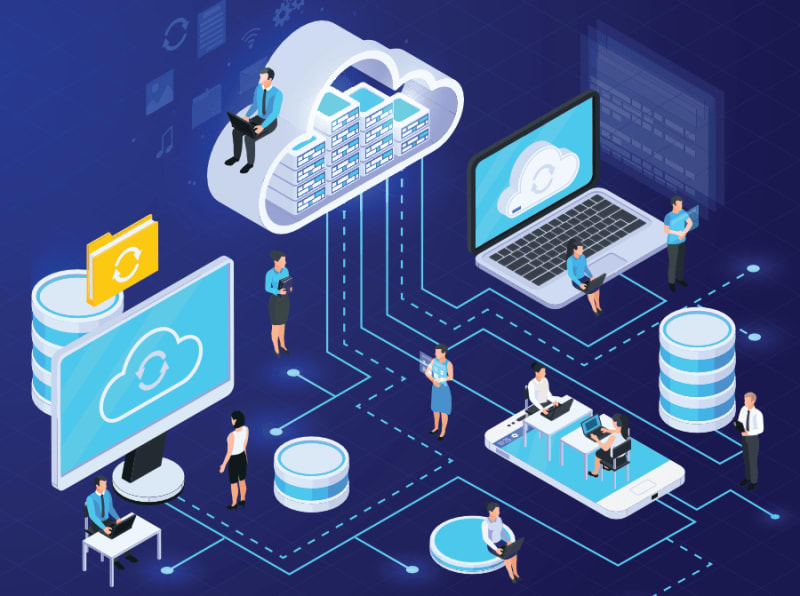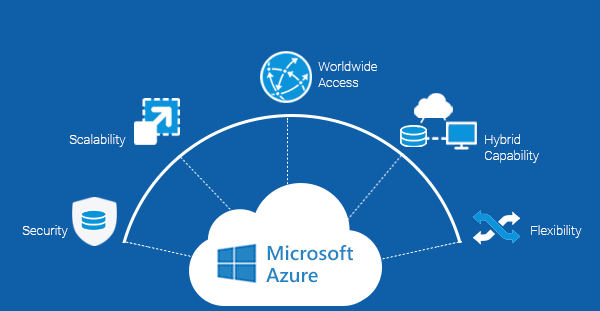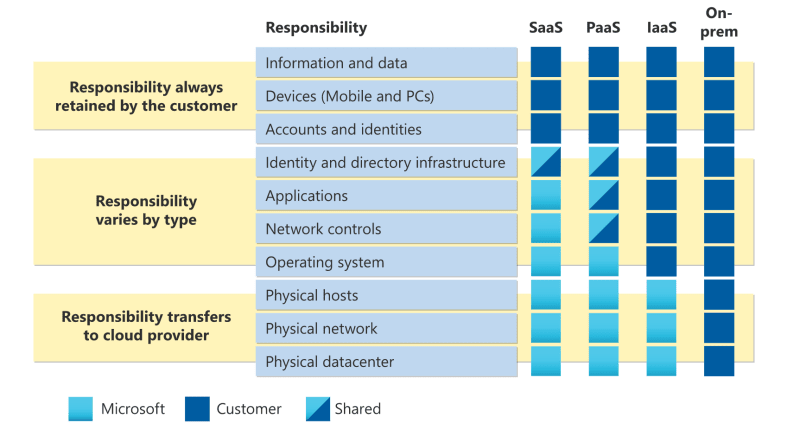Microsoft Azure is one of the most popular cloud computing platforms, providing a wide range of services to help businesses and organizations meet their computing needs. To understand Microsoft Azure, it is important to first grasp the basic concepts of cloud computing.
In Microsoft Azure Fundamentals: Describe cloud concepts , there are 3 learning paths [Describe cloud computing, Describe the benefits of using cloud services and Describe cloud service types] which helps us to know about the concept thoroughly. This blog will cover the summary I learnt while completing the training path. Now I will share my learning outcome with you guys.
Before starting lets know about Azure.
What is Azure?
→ Microsoft Azure is a cloud computing platform with an ever-expanding set of services to help you build solutions to meet your business goals. Azure's web services allows businesses to host their presence in the cloud, as well as fully virtualized computers to manage custom software solutions. Additionally, Azure offers various cloud-based services such as remote storage, database hosting, and centralized account management. Furthermore, Azure provides new capabilities such as artificial intelligence and Internet of Things services.
What is Azure Fundamentals?
→Azure Fundamentals is a program consisting of three learning paths that introduce users to Azure's services and features. It includes interactive exercises and a temporary Azure portal environment for practice. No technical IT experience is required, but general IT knowledge is helpful. You should take this course if you:
● Have general interest in Azure or in the cloud
● Want to earn official certification from Microsoft (AZ-900)
AZ-900 Domain Area Weight
- Describe cloud concepts 25-30%
- Describe Azure architecture and services 35-40%
- Describe Azure management and governance 30-35%
Cloud computing
#Introduction to cloud computing:-
→The module provides an introduction to cloud computing, covering general cloud concepts such as shared responsibility, different cloud models, and pricing methods. The learning objectives include defining cloud computing, describing the shared responsibility model, identifying appropriate use cases for public, private, and hybrid cloud models, and comparing cloud pricing models. This module may be a review for those already familiar with cloud
computing.
#What is cloud computing?
→ Cloud computing is the delivery of computing services, such as virtual machines, storage, databases, networking, IoT, ML, and AI, over the internet. Unlike traditional data centers, cloud computing is not constrained by physical infrastructure. This allows for rapid expansion of IT infrastructure without having to wait for the construction of a new data center. Like in cloud
computing services, users just have to pay for the resources he use. He doesn't have to think about the computational power or storage capacity and the hardware part is also taken care of
by the service provider. So the user doesn't have to worry about that.
#Describe the shared responsibility model
→ In this responsibility model physical security, power, cooling, and network connectivity are the responsibility of the cloud provider where the consumer is responsible for the data and
information stored in the cloud and also responsible for access security, meaning you only give access to those who need it.
The shared responsibility model refers to the distribution of responsibilities between the cloud provider and the consumer. This distribution of responsibilities depends on the type of cloud service:
Infrastructure as a service (IaaS), platform as a service (PaaS), and software as a service (SaaS).
In IaaS, the provider takes care of physical security, power, and connectivity, while the consumer is responsible for the rest, including operating system, applications, and data.
In SaaS, the provider takes care of almost everything, including applications, data, and infrastructure, with the consumer being responsible for only a small portion of the service.
In PaaS, the responsibility is evenly distributed between the provider and the consumer. The provider takes care of the infrastructure and middleware, while the consumer is responsible for the applications and data.
Understanding the shared responsibility model is important as it helps organizations determine the level of control and security they have over their data and infrastructure in the cloud.
The picture explains that organizations are always responsible for the data stored in the cloud,devices that connect to the cloud, and accounts and identities within the organization. The cloud
provider is responsible for the physical datacenter, network, and hosts. The specific responsibilities for operating systems, network controls, applications, identity, and infrastructure
depend on the chosen service model (IaaS, PaaS, SaaS).
Cloud Modules
The cloud models define the deployment type of cloud resources. The three main cloud models are: private, public, and hybrid.
Private cloud: A cloud used by a single entity, either hosted on site or in a dedicated datacenter offsite. Provides more control and security, but also comes with greater cost and fewer benefits than public cloud deployment.
Public cloud: Built, controlled, and maintained by a third-party cloud provider. Offers general public availability to anyone who wants to purchase cloud services.
Hybrid cloud: A computing environment that uses both public and private clouds in an interconnected environment. Offers flexibility and an extra layer of security by allowing users to
choose which services to keep in public or private cloud infrastructure.
There are other modules also like :-
Multi-cloud: A scenario where multiple public cloud providers are used to manage resources and security across different cloud environments.
Azure Arc: A set of technologies that helps manage your cloud environment, regardless of whether it's public or private cloud, hybrid, or multi-cloud.
Azure VMware Solution: A solution that allows VMware workloads to be run in Azure with seamless integration and scalability for those who want to migrate from a private cloud environment to public or hybrid cloud.
consumption-based mode
When comparing IT infrastructure models, there are two types of expenses to consider:
Capital expenditure (CapEx): A one-time, up-front expenditure to purchase or secure tangible resources (e.g. building a datacenter).
Operational expenditure (OpEx):Spending money on services or products over time (e.g.renting a convention center).
Cloud computing falls under OpEx because it operates on a consumption-based model.
Instead of paying for physical infrastructure, electricity, and security, you pay only for the IT resources you use. This consumption-based model has many benefits, including:
No upfront costs.
No need to purchase and manage costly infrastructure that users might not use to its fullest potential.
The ability to pay for more resources when they're needed.
The ability to stop paying for resources that are no longer needed.
With a traditional datacenter, estimating future resource needs is crucial. Overestimating leads to wasted money, while underestimating can lead to decreased performance. In a cloud-based model, you don’t have to worry about getting the resource needs just right.
Cloud computing allows you to rent compute power and storage from someone else’s datacenter, treating cloud resources like your own. Unlike in your own datacenter, you only pay for what you use, and the cloud provider takes care of maintaining the underlying infrastructure for you.
In summary, cloud computing is a cost-effective, flexible, and scalable solution for businesses of all sizes.
Describe the benefits of using cloud services
High Availability:
● High availability ensures maximum availability of IT resources, even during disruptions or events that may occur.
● Azure provides highly available cloud environments with uptime guarantees depending on the service.
● Service-level agreements (SLAs) outline these guarantees.
Scalability:
● Scalability refers to the ability to adjust resources to meet demand.
● Cloud resources are scalable, meaning you can add or subtract resources to handle increased or decreased demand.
● Scaling comes in two varieties: vertical and horizontal scaling.
● Vertical scaling increases or decreases the capabilities of resources, while horizontal scaling adds or subtracts the number of resources.
Reliability:
● Ability of a system to recover from failures and continue functioning.
● Azure's decentralized design supports a reliable and resilient infrastructure.
● Applications can be designed to automatically take advantage of global scale for
increased reliability.
Predictability:
● Predictability in the cloud lets you move forward with confidence.
● Performance and cost predictability are influenced by the Azure Well-Architected Framework.
Performance:
● Autoscaling, load balancing, and high availability support performance predictability.
● Autoscaling can deploy additional resources to meet demand, while load balancing helps redirect traffic to less stressed areas.
Cost:
● Cloud analytics and tools like TCO and Pricing Calculator can help predict future costs.
● You can adjust your resources as needed to better manage and predict cloud spend.
Governance:
● Set templates help ensure that all your deployed resources meet corporate standards and government regulatory requirements.
● Cloud-based auditing helps flag any resource that’s out of compliance with your corporate standards and provides mitigation strategies.
● Depending on your operating model, software patches and updates may also automatically be applied.
Security:
● You can find a cloud solution that matches your security needs.
● Infrastructure as a service provides you with physical resources but lets you manage the operating systems and installed software, including patches and maintenance.
● Platform as a service or software as a service deployments may be the best cloud strategies for you if you want patches and maintenance taken care of automatically.
● Cloud providers are typically well suited to handle things like distributed denial of service (DDoS) attacks, making your network more robust and secure.
Manageability:
Cloud computing offers two types of manageability options:
- management of the cloud and
- management in the cloud.
Management of the cloud involves managing your cloud resources, which can be done in several ways in the cloud environment. You can scale resource deployment automatically based on need, deploy resources using preconfigured templates instead of manual configuration, monitor resource health and automatically replace failing resources, and receive automatic alerts based on configured metrics, giving you real-time performance updates.
Management in the cloud involves managing your cloud environment and resources through various interfaces, including a web portal, command line interface, APIs, and PowerShell. These
options provide flexibility in managing your resources and allow you to choose the best method for your needs.
cloud service types
- Infrastructure as a Service (IaaS),
- Platform as a Service (PaaS), and
- Software as a Service
(SaaS) are three different cloud computing models that offer various levels of management and control over IT resources.
IaaS is most flexible and provides physical resources such as servers, storage, and networking, which customers can manage themselves, including the operating system, middleware, and
applications.
PaaS offers a higher level of abstraction by providing customers with a platform to build and deploy applications without having to manage the underlying infrastructure. The customer only
needs to manage the application and data.
SaaS is the most abstract model and provides customers with access to software applications that are fully managed by the provider. Customers can use the software over the internet without having to install, manage, or update it.











Top comments (0)